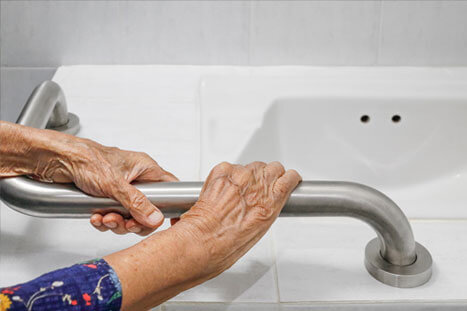
You can use many different strikes in self-defense situations. The attack's location and proximity will dictate which strike you use. For example, if the attacker is on your upper body, you should use your hand. For soft targets, you can strike with a knife hand position or a palm strike. Another strike that works is to curl your fist tightly is the fist.
Block outward
The outward blocking is similar to a boxer’s parry but you do not take the opponent's punch. Instead, you block them outside. This block can either be done on the ribs, face or midsection depending upon where the opponent is going with his punch.

Side elbow
The side elbow is an effective defensive move. It is a useful defensive move because the elbow bone is thicker than the bone in your hand. This means it can be used to block an opponent from punching. It can inflict severe damage when used in self defense.
Eye strike
The eye strike can be used to inflict or excite an opponent and is a very basic form of self defense. It can be performed with your thumb, fingers, or thumb. When used properly, it is very powerful. The key is to make sure that your strikes are powerful, resolved quickly, and are repeated.
Rotate your wrists
If someone tries grab you by the wrists, the best defense is to rotate your wrists. This will allow for you to escape from the attack using the least force possible. You can also use your shoulder power to free yourself from a hold by the attacker if they are holding you down with a firm grip.
Flattening an assailant’s ear with your flat hand
Slapping an assailant with a flat hand can be an effective self-defense technique that can be used to stop an attack. It is easy to reach the mandibular angle nerve with a weak arm. It is best to place your hand at the armpit when you are slapping someone. Then you can go the opposite way and slap him/her in the ear.

Avoid confrontation
Avoiding confrontation is an essential part of self-defense. You only have two seconds to react to a confrontation and make a move. You don't want to be a target. To avoid being hit, it is important to stay calm and alert to your surroundings. If an attacker approaches, keep your eyes on the person's back and neck.
FAQ
How to stay safe if you aren't physically able to protect yourself?
If you aren't physically able defend yourself from an attack, then you should seek out someone who is.
You may have to ask for help. You might need to call 911. But if you don't take any action, you could die.
You can also reach out to your local domestic violence shelter. Many shelters offer safety planning classes for women to learn how to protect their own safety.
What does it cost to sign up for a course in self-defense?
There are many selfdefense courses. The cost of self-defense courses varies depending upon where you live and whether or not you take them online.
Some schools charge about $50 per calendar month, while others charge up $200.
You can find a low-cost option at your local community center. Many of these places offer free self-defense lessons.
Can I legally own a stungun?
Yes. You will need a permit from the state.
To apply for a permit, you must fill out an application form and pay a fee.
Once you receive your permit, you must keep it in a visible place (like your wallet).
If you lose your permit, then you will be required to go through the process again.
What are some of the benefits of learning martial arts?
Martial arts training helps you develop skills you can use in any situation. These skills will help you grow stronger and quicker. They teach you how deal with various types of attacks.
They can also increase your confidence. If you feel secure, you are more likely to be relaxed and less stressed.
They can also be beneficial for your health. Research shows that exercise can improve your overall health.
What should I be looking for in a Self-Defense Class?
Consider the reputation of the instructor and their experience in self-defense classes. Ask about their credentials and background.
Ask if they offer discounts or free trials. Many instructors offer discounts or free trials to new students.
Ask if online classes are offered.
Ask if they provide emergency medical care after every class. This is especially important if you get injured during a class.
Make sure you find a class with a variety of exercises. This ensures that you have plenty of time for each technique to be tried before moving on to another.
Statistics
- Most likely, you'll get tapped out by 90% of the people in your first 3-5 months. (mmaclan.com)
- Boxers aren't allowed to fight in a clinch, which is a position that occurs in 80% of the streetfights. (mmaclan.com)
- Some people walk into a gym thinking they are going to become the best by training whenever they like and not putting 100% effort in. (budodragon.com)
- Saying this, Self defense 101 would be the importance of situational awareness, which can never be replaced by the finest of martial arts, because it is this that would help you to avoid any likely attacks in the first place. (worldofselfdefense.com)
External Links
How To
How To Survive A Home Invasion
Home invasion is scary, especially for children. We didn’t know that we would be experiencing it ourselves as we embarked on our home security system installation adventure. Here's the information we've gleaned so far.
-
Do not let your children see the attackers. Two men broke into our home upstairs while our kids were sleeping. They were kept downstairs until the police arrived. Although our children weren't injured, they were traumatized enough.
-
Lock up all valuables. In our bedroom, we keep valuables safe. Even if someone broke into the house, they won’t have access to it.
-
Keep an Eye out for Burglars. Our neighborhood has many burglaries. We pay attention to suspicious cars and people.
-
Always have a backup plan. If anything happens to us, our family will be taken care of financially. We also have a plan that allows us to leave the United States if necessary.
-
Always be prepared You must be prepared if you find yourself in a position where you have to defend your life. Always have food, water, or other supplies on hand.
-
Call 911 First. Call 911 immediately if you suspect that someone has broken into the house. It's safer to call the authorities immediately than to wait for them at your door.
-
Use Common Sense. You won't allow anyone in who isn't right for you. Also, don't invite strangers to come over.
-
Reach out to your neighbours or other residents in your area for assistance. If you feel uneasy, call friends or neighbors. You can have them watch your back while calling the police.
-
Stay Calm And Do As Instructed By Police Officers. Stay calm and do exactly as instructed by officers. Do not flee or resist arrest
-
Photograph Any Evidence. Photograph all evidence you find during the investigation. This includes blood samples and fingerprints.
-
Local Law Enforcement can be contacted to file a report. Even if you are not the victim, it is a good idea to file a report with local law enforcement. You may be able to prevent other crimes.
-
Call the Insurance Company immediately. You should immediately contact your insurance company. Tell your insurance company everything that has happened, and ask them to send an adjuster.
-
Remove Personal Belongings. Before you leave the scene, remove personal belongings. Don't wear expensive jewelry. Take it off and put it away.
-
Take Care of Yourself. Make sure you clean up after yourself. Take out the trash and break glass and lock all doors and windows.
-
Don't talk about the events. Don't talk about anyone's past. You never know who might attempt to use this information against later.